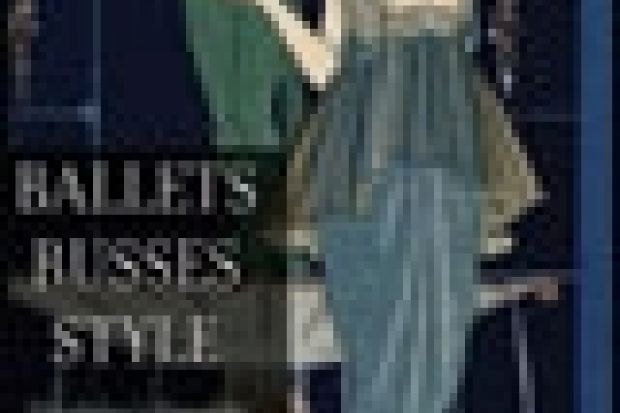If style, as Susan Sontag pithily proposed, is the "signature of an artist's will", the style of the Ballets Russes could be understood as Serge Diaghilev's determination to crystallise a startlingly sumptuous aesthetic for the modern age. From its inception in 1909 in Paris until Diaghilev's death in 1929, the Ballets Russes mined the ingenuity of a prodigious array of dancers, choreographers, composers and designers to produce spectacles that - as evidenced by the current Victoria and Albert Museum exhibition on the company's golden age - continue to beguile and delight. While the impact of the company on modern art, music and choreography is well charted, Mary Davis' book surveys the less well-scrutinised interplay between the company and haute couture.
Davis traverses the gamut of Ballets Russes' stylistic modes: the vividly tinctured, frankly erotic glamour of Léon Bakst's "orientalist" designs for works such as Cléopâtre (1909) and Scheherazade (1910); the Modernist refashionings of Russia's pagan ancestry, as in Le Sacre du Printemps (1913); evocations of the ancient world in L'Après-midi d'un Faune (1912) and Narcisse (1924); and the à la mode tennis outfits of Jeux (1913) or Coco Chanel's Riviera-chic apparel for Le Train Bleu (1924).
The illustrated magazines Comoedia Illustre and La Gazette du Bon Ton played a crucial role in disseminating the company's stylistic fecundity to a public hungry for Russian(ish) exotica. Comoedia Illustré, for instance, produced high-spec Ballets Russes supplements to its regular issues, as well as gorgeously illustrated programmes. The reproductions from Comoedia, including ballerina Lydia Lopokova lounging in elegant eveningwear and a breast-baring Natacha Trouhanova dancing Salomé, offer fascinating glimpses of the prevailing tastes and celebrity culture of the era. Unfortunately, the petite dimensions of Ballets Russes Style make it difficult to decipher the accompanying text.
Davis skilfully articulates the varied degrees of interaction between the Ballets Russes and the era's most influential couturiers. Paul Poiret, for instance, never designed for the company, although his sensuously vibrant collections patently engage with the Ballets Russes-inspired vogue for an intoxicatingly decadent East. Poiret favoured richly textured fabrics and shunned the pallid hues and physically restrictive constructions that had dominated turn-of-the-century female fashion. His renown was such that The New Yorker proclaimed him, along with Ballets Russes affiliates Bakst and Henri Matisse, as helping to "change the modern retina".
In June 1911, Poiret hosted a "Thousand and Second Night" fête, compelling 300 of his most stylish acquaintances to attend, as if supernumeraries from Scheherazade, in costumes "inspired by the Oriental tales". Sultan "Poiret the Magnificent" welcomed his guests, while his wife Denise, dressed in harem pants and a jewelled bustier, was kept on display in an enormous gilded cage. The designer took pains, nonetheless, to disclaim being influenced by the Ballets Russes, writing that Bakst's costumes were "really too over the top to inspire any couturier working in the reality of everyday life". The prestigious fashion atelier Maison Paquin evidently thought otherwise, hiring Bakst in 1912 to sketch ensembles for its collection.
Chanel's alliance with the Ballets Russes was more direct, yet also encompassed subtle gradations of aesthetic exchange. In the early 1920s, she had an affair with Igor Stravinsky, Diaghilev's favoured composer, and subsequently took up with Dmitri Pavlovitch, Tsar Nicholas II's nephew. A "Russian phase" ensued, as her streamlined style gave way to brightly coloured garments echoing the shape of Russian peasant tunics. The Grand Duke's sister, Duchess Marie, headed up Chanel's embroidery atelier, and many of her salesgirls and models (among them Stravinsky's niece) were likewise Russian émigrés.
In the wake of her Russian phase, Chanel's costumes for Le Train Bleu, featuring bathing suits and golf wear, catapulted street style to the realm of high art. Davis convincingly argues that Chanel's "slangy chic" exemplified an "alternative strand of modernism" that significantly influenced artists working across a range of media.
Davis' vantage point offers intriguing insights into the broader cultural impact of Diaghilev's enterprise. Her book is a welcome addition to recent scholarship on the Ballets Russes and its enduring allure.
Ballets Russes Style: Diaghilev's Dancers and Paris Fashion
By Mary E. Davis Reaktion Books, 256pp, £17.95 ISBN 9781861897572 Published 25 October 2010
Register to continue
Why register?
- Registration is free and only takes a moment
- Once registered, you can read 3 articles a month
- Sign up for our newsletter
Subscribe
Or subscribe for unlimited access to:
- Unlimited access to news, views, insights & reviews
- Digital editions
- Digital access to THE’s university and college rankings analysis
Already registered or a current subscriber? Login
